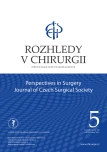Penetrating abdominal trauma – selected case reports
Authors:
P. Svoboda 1; R. Doležel 1; P. Kupka 2; J. Rudiš 1; Radek Pohnán 1
Authors‘ workplace:
Chirurgická klinika 2. lékařské Fakulty Univerzity Karlovy a Ústřední vojenské nemocnice Praha
1; Oddělení Emergency Ústřední vojenské nemocnice Praha
2
Published in:
Rozhl. Chir., 2021, roč. 100, č. 5, s. 246-251.
Category:
Case Report
doi:
https://doi.org/10.33699/PIS.2021.100.5.249–254
Overview
We present 3 case-reports with penetrating abdominal injury from our practice in this article. An urgent laparotomy was performed in all cases because of haemodynamic instability or the mechanism of injury. Penetrative abdominal traumas are associated with a high risk of life-threatening intra-abdominal injuries, require urgent revision and are often accompanied by postoperative infections of the peritoneal cavity. In recent years, there has been a growing tendency towards mini-invasive approaches or even non-operative treatment. This trend is particularly evident in the United States of America, where doctors experience a higher number of penetrating injuries compared to the prevalent blunt force trauma in Europe. The authors describe the need to follow all recommended procedures in the pre-hospital and hospital phases of treatment of these patients and compare them with recent literature. Key words: penetrating abdominal trauma
Keywords:
penetrating abdominal trauma − ATLS – advanced trauma life support − damage control surgery
Sources
1. Věstník Ministerstva zdravotnictví ČR MZ 1/2021:16–17.
2. Casali M, Di Saverio S, Tugnoli G, et al. Penetrating abdominal trauma: 20 years experience in a Western European Trauma Center. Ann Ital Chir. 2008 Nov– Dec;79(6):399−407. PMID:19354033.
3. Costa G, Tierno SM, Tomassini F, et al. The epidemiology and clinical evaluation of abdominal trauma. An analysis of a multidisciplinary trauma registry. Ann Ital Chir. 2010 Mar–Apr;81(2):95−102. PMID:20726387.
4. Kuza CM, Hirji SA, Englum BR, et al. Pancreatic injuries in abdominal trauma in US adults: Analysis of the National Trauma Data Bank on management, outcomes, and predictors of mortality. Scand J Surg. 2020 Sep;109(3):193−204. doi:10.1177/1457496919851608. Epub 2019 May 29. PMID:31142209.
5. Bain K, Meytes V, Chang GC, et al. Laparoscopy in penetrating abdominal trauma is a safe and effective alternative to laparotomy. Surg Endosc. 2019 May;33(5):1618−1625. doi:10.1007/ s00464-018-6436-1. Epub 2018 Sep 12. PMID:30209608.
6. Malkomes P, Störmann P, El Youzouri H, et al. Characteristics and management of penetrating abdominal injuries in a German level I trauma center. Eur J Trauma Emerg Surg. 2019 Apr;45(2):315−321. doi:10.1007/s00068-018-0911-1. Epub 2018 Jan 22. PMID:29356844.
7. Waes OV, Lieshout EV, Silfhout DV, et al. Selective non-operative management for penetrating abdominal injury in a Dutch trauma centre. Ann R Coll Surg Engl. 2020 May;102(5):375−382. doi:10.1308/ rcsann.2020.0042.
8. Laing GL, Skinner DL, Bruce JL, et al. A multi-faceted quality improvement programme results in improved outcomes for the selective non-operative management of penetrating abdominal trauma in a developing world trauma centre. Injury 2014 Jan;45(1):327−332. doi:10.1016/j.injury.2013.08.021.
9. Goin G, Massalou D, Bege T, et al. Feasibility of selective non-operative management for penetrating abdominal trauma in France. J Visc Surg. 2017 Jun;154(3):167−174. doi:10.1016/j.jviscsurg. 2016.08.006. Epub 2016 Nov 14. PMID:27856172.
10. Galvagno SM Jr, Nahmias JT, Young DA. Advanced Trauma Life Support® update 2019: Management and applications for adults and special populations. Anesthesiol Clin. 2019;37(1):13−32. doi:10.1016/j. anclin.2018.09.009.
11. Teuben M, Löhr N, Jensen KO, et al. Improved pre-hospital care efficiency due to the implementation of pre-hospital trauma life support (PHTLS®) algorithms. European Journal of Trauma and Emergency Surgery 2020;46:1321–1325. doi:10.1007/s00068-019-01141-1.
12. Biffl WL, & Moore EE. Management guidelines for penetrating abdominal trauma. Current opinion in critical care 2010;16(6):609−617.
13. Biffl WL, & Leppaniemi A. Management guidelines for penetrating abdominal trauma. World J Surg. 2015;39(6):1373−1380.
14. Wang Y, Alnumay A, Paradis T, et al. Management of open abdomen after trauma laparotomy: A comparative analysis of dynamic fascial traction and negative pressure wound therapy systems. World J Surg. 2019 Dec;43(12):3044−3050. doi:10.1007/s00268-019-05166-w. PMID: 31506714.
15. Hall C, Regner J, Abernathy S, et al. Surgical site infection after primary closure of high-risk surgical wounds in emergency general surgery laparotomy and closed negative-pressure wound therapy. J Am Coll Surg. 2019 Apr;228(4):393−397. doi:10.1016/j.jamcollsurg.2018.12.006. Epub 2018 Dec 23. PMID:30586643.
Labels
Surgery Orthopaedics Trauma surgeryArticle was published in
Perspectives in Surgery

2021 Issue 5
- Metamizole vs. Tramadol in Postoperative Analgesia
- Metamizole at a Glance and in Practice – Effective Non-Opioid Analgesic for All Ages
- Possibilities of Using Metamizole in the Treatment of Acute Primary Headaches
Most read in this issue
- Negative pressure wound therapy updates for 2021
- Posttraumatic intercostal pulmonary herniation – case report
- Penetrating abdominal trauma – selected case reports
- Ten years of laparoscopic sleeve gastrectomy at the Military University Hospital in Prague
